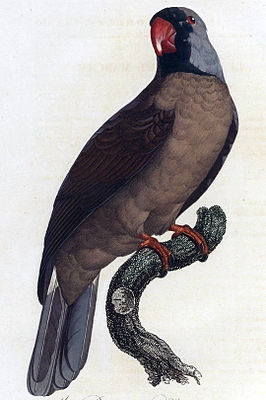Réunion parakeet
| Réunion parakeet | ||||||||||||
|---|---|---|---|---|---|---|---|---|---|---|---|---|

European Union Parakeet ( Mascarinus mascarinus ); Illustration by Jacques Barraband from L'Histoire Naturelle des Perroquets (1805). |
||||||||||||
| Systematics | ||||||||||||
|
||||||||||||
| Scientific name of the genus | ||||||||||||
| Mascarinus | ||||||||||||
| Lesson , 1831 | ||||||||||||
| Scientific name of the species | ||||||||||||
| Mascarinus mascarinus | ||||||||||||
| ( Linnaeus , 1771) |
The Mascarene Parrot ( Mascarinus mascarinus ) or Maskarenenpapagei is an extinct species of parrot . It was the only species of the genus Mascarinus and inhabited Réunion and possibly Mauritius . The approximately 35 cm tall bird had a red beak, black and gray colored head plumage and dark gray body plumage.
The Réunion parakeet died out in the wild after 1770; in captivity, the species survived until the 1780s.
features

The Réunion parakeet was a medium-sized parrot with a body length of around 35 cm and the size of a parrot . Its head was comparatively large for a parrot its size; its beak and claws were also relatively strong. Its tail, consisting of twelve feathers, was not stepped, but slightly rounded at the end.
The head of the Réunion parakeet was feathered light blue-gray, around the beak was a black band that either ran down the throat or also covered its sides. The back, belly, rump and wings were obviously dark gray. Descriptions that speak of a brown trunk and brown wings no longer refer to living individuals, but to specimens that appear to have discolored over time. The middle two control springs were uniformly colored dark ash gray; the outer ten had the same basic color, but were colored white from the base to about a third of the total length.
The beak and wax skin were bright red, as was the skin around the eyes. The iris was red. The featherless lower legs of the parrot were pale, the claws colored gray-brown.
distribution
As things stand today, the range of the Réunion parakeet only included the island of Réunion . Here the species was described and subfossil bone material was found. It is unclear whether the Réunion parakeet was also native to nearby Mauritius .
Taxonomy
Research history
The Réunion parakeet is first mentioned in 1674 in the travelogue of Père Dubois , who speaks of "parrots, slightly larger than a dove, with plumage of squirrel gray color, a black cap on the head, the beak large, strong and of fiery color". In the taxonomic sense, the Réunion parakeet was first described in 1760 by Mathurin-Jacques Brisson as Psittacus Mascarinus , but not according to the current rules for binomial . Carl von Linné's description as Psittacus mascarinus from 1771 is therefore valid . René-Primevère Lesson finally placed the species in its own genus Mascarinus in 1831 .
Systematics
Like most bird species in the Mascarene Islands, the ancestor of the Réunion parakeet probably colonized Réunion over the islands of the northern Indian Ocean . Like other parrot genera of the Mascarene, Mascarinus does not originate from radiation on site, but comes from a separate colonization, the species is probably of younger origin than the Rodrigues parrot ( Necropsittacus rodericanus ) and the Mauritius parrot ( Lophopsittacus mauritianus ). The exact relationship is unclear. A relationship to the Réunion gray parakeet ( Psittacula cf. bensoni , possibly con-specific with the Mauritius gray parakeet ), which was also predominantly gray in color, would be possible. The red and broad beak of the mascarine parrot speaks for a classification in the tribe Psittaculini .
die out
The Réunion parakeet disappeared in the 1770s. It is unlikely that its extinction was primarily due to rats or cats, which by then had already existed on the island for around a century. It is more likely that the species succumbed to hunting pressure from escaped slaves who fed on wild birds in the island's inaccessible highlands. Some birds survived in captivity in Paris until at least 1784.
Sources and References
literature
- Anthony S. Cheke, Julian Hume: Lost Land of the Dodo. An Ecological History of Mauritius, Réunion & Rodrigues. T & AD Poyser, London 2008, ISBN 978-0-7136-6544-4 .
- AW Diamond (Ed.): Studies of Mascarene Island Birds . Cambridge University Press, Cambridge 1987. ISBN 0-521-25808-1 .
- Julian Pender Hume: Reappraisal of the Parrots (Aves: Psittacidae) from the Mascarene Islands, With Comments on their Ecology, Morphology, and Affinities . In: Zootaxa 1513, 2007. pp. 1-76. (Online as PDF )
- René-Primevère Lesson: Traité d'ornithologie . FG Levrault, Paris 1831. ( Online at archive.org )
- Carl von Linné: Mantissa Planatarum altera Generum editionis VI et Specierum Editions II; Regni animalis appendix. 1771.
Web links
- Lifelike reconstruction of the Reunion Parakeet by Julian Hume, www.julianhume.co.uk.
- Mascarinus mascarin inthe IUCN 2013 Red List of Threatened Species . Listed by: BirdLife International, 2012. Retrieved December 14, 2013.
Individual evidence
- ↑ a b Lesson 1831 , pp. 188-189.
- ↑ a b Linné 1771 , p. 524.
- ↑ a b c d Cheke & Hume 2008 , p. 177.
- ↑ Hume 2007 , p. 38.
- ↑ Hume 2007 , pp. 41-42.
- ↑ Cheke & Hume 2008 , p. 59.
- ↑ Hume 2007 , pp. 40-41.
- ↑ Diamond 1987 , p. 20.
